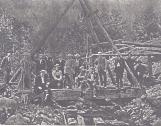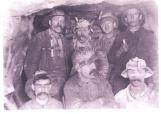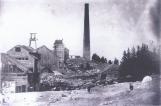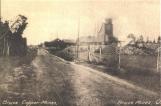14
The following factors contributed to the mines operating at a loss in 1853-1854:1. They had been working poorer stopes with less copper content.
2. Higher wages were being paid to the miners.
3. Manpower was being lost to build a canal for the locks in nearby Sault Ste. Marie, Michigan.
4. The company had recently lost a winter supply ship at sea in the fall of 1854.
15
There were numerous stories as to the discovery of different sections of the mines. One of the more inadvertent finds took place in 1854, when a cow being driven home by its owner, George Clark, a miner-farmer, slipped on a moss-covered rock and exposed a vein of ore, subsequently called the 'Fire Lode'. The newly formed West Canada Mining Company investigated and discovered other veins rich in copper.16
This observation was made by J. Disturnell in 1857."…The mines are situated in the immediate vicinity of the village, there being ten openings or shafts from which ore is obtained in its crude state. Horsepower is mostly used to elevate the ore; the whims are above ground, attached to which are ropes and buckets."
17
In 1867 the Bruce Mines were operating at their peak. The town was a large settlement around the mines, with thriving businesses, and several churches and schools. The West Canada Mining Company employed 300-400 men and wages were exceedingly good.18
In 1868, John Taylor, Jr., Manager of the West Canada Mining Company, reported on the high cost of mining copper at Bruce Mines. He mentioned three main factors contributing to this high cost:1. The cost of dressing the ore was very heavy.
2. They were using a system of washing that resulted in large amounts of copper being lost.
3. Freight rates, when shipping the ore from the mine to England, were very high.
His recommendations were to smelt the ore on location in Bruce Mines, and to adopt "the salt process" to reduce the amount of copper lost in the current system of washing. Both of his recommendations were attempted, but were not found to be financially feasible for the company.
20
Photo courtesy of Winnogene Sturgeon.22
Photo courtesy of the Mitchell and Marjorie Fleming family.24
Photo courtesy of Merritt Strum.25
According to the 1871 Census, the only company operating in the area was the West Canada Mining Company Limited. The average number of people employed over the last year was 167 men and 39 boys.In the 1870's new industries, such as agriculture and logging, became more important due to the uncertainty associated with mining. Then in 1876 a cave-in occurred in the West Canada section at the junction of the Fire and Main Lodes. No miners were present and no injuries occurred, however an underground stockpile of ore was completely buried. A period of local mining history, spanning 30 years was now ending. Most of the Cornish miners and their families migrated to mining camps in the United States.



